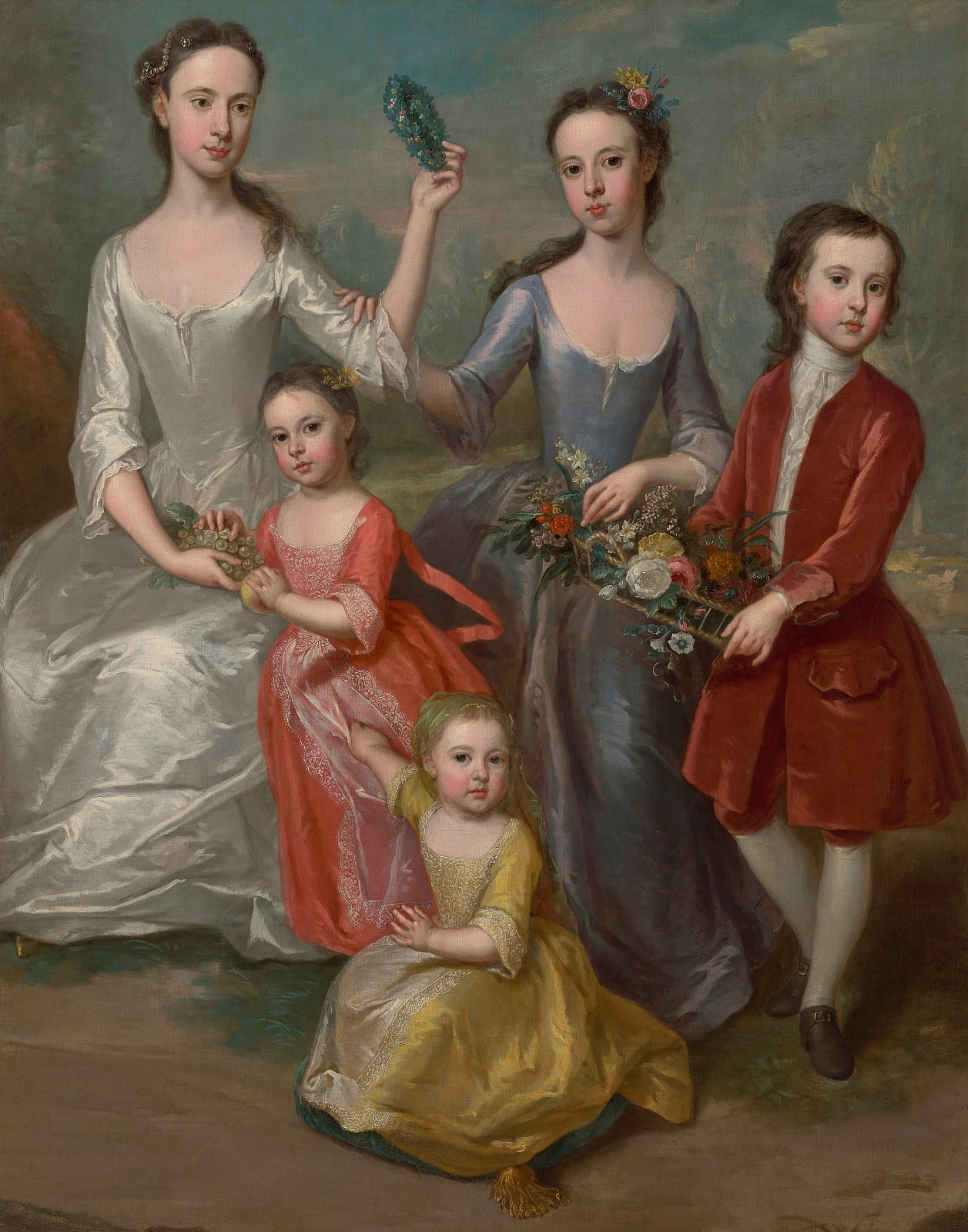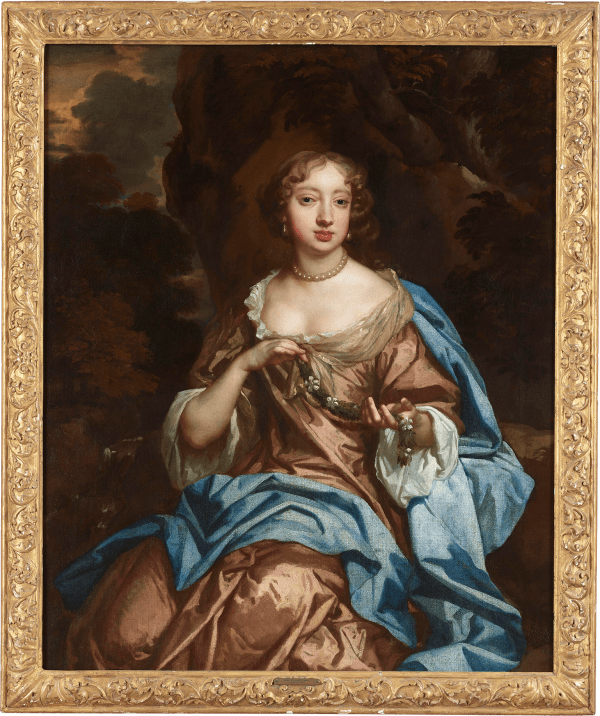
William Aikman
For all available works visit philipmould.com
This endearing family portrait of five children in a landscape is an excellent example of late-Baroque English portraiture and is an exciting new addition to William Aikman’s recorded oeuvre.
The purpose of child portraiture changed dramatically in the late seventeenth and early eighteenth centuries. During the Tudor and Stuart period children were generally portrayed in a manner which focussed on their family’s wealth or the child’s suitability for marriage. As the arts in England matured and more flamboyant ‘baroque’ aesthetics took over, child portraiture became more sensitive and the concept of innocence, which in previous decades had been supressed, was now embraced and even celebrated.
Seriousness has been replaced by youthful energy and playfulness in the present portrait which depicts four sisters with their brother. The composition is masterfully composed with each sibling physically connected by an extending arm or other visual prop. They eye is thus lead from one child to the next and the overall feeling is one of love, intimacy and new life, as hinted by the flowers and fruit.
The youngest child – a little girl as evinced by her head shawl – is seated on a cushion at the bottom of the composition and gently pulls at her elder sister’s red dress, who in turn glances out of the composition as she picks a grape from a bunch held in the hand of the eldest sister. The eldest sister, who is on the cusp of adulthood, commands the composition and holds a floral wreath in her raised arm. The flowers are an allusion to spring and the start of new life, and their circular shape is a reference to eternity –the message here, perhaps, is one of eternal faithfulness to a future husband. Her raised arm is momentarily held back by her sister - the second-eldest child - who with her left hand fondles a basket of flowers held by her brother.
The ambition of this work is unprecedented within Aikman’s portraits of non-royal subjects and can rightly be considered one of his most impressive works. Only one other painting – a group portrait of Frederick, Prince of Wales with his brothers and sisters [Chatsworth House] – can be considered more ambitious. Besides the Chatsworth painting, we know of only one other group portrait by Aikman on this scale – a depiction of the The Hon. John and The Hon. Thomas Hamilton with a black servant [private collection]. Although slightly smaller in scale than the present work, the Hamilton portrait shares obvious similarities - in both portraits, for example, the children are shown in an open landscape with a basket of flowers. In fact, Aikman has used the same basket in both portraits – it was clearly a favourite studio prop.
It was only after William Aikman’s education at the University of Edinburgh that he decided to train as a painter. He learnt his craft by working as an assistant for John de Medina (1659-1710), one of the most prominent artists working in Edinburgh of that date. Seeking to further his studies, he travelled to London, where he enlisted at one of the artists’ academies there, most likely the Rose and Crown. Here he would have been provided with access to a life model – an essential requirement of the artist’s professional formation in this period.
More unusual is the fact that Aikman decided to travel abroad to further his studies. In the years before the Grand Tour had become the widespread social phenomenon of the later eighteenth century, Aikman was ambitious in his travels, pursuing an itinerary that took him through Italy to Turkey and back again. Returning to Scotland in 1711, his knowledge of the greatest works of the Italian Renaissance and beyond would have separated him from his contemporaries and meant that he was well-placed to inherit the practice of Medina, who had died in the preceding year.
Aikman’s painterly style, informed by the Continental Baroque, quickly won him prominent patrons and the influential Scot, John Campbell, 2nd Duke of Argyll (1680-1743), soon insisted on inviting him to London. Aikman came reluctantly – fearful of the expense that maintaining an artist’s studio in London entailed. But, following a trial period (and the death of Sir Godfrey Kneller (1646-1723), decided to make his career in the city that was – thanks to the Act of Union of 1707 – now the capital city of the United Kingdom. Aikman was widely patronised. He painted influential taste-maker, Richard Boyle, 3rd Earl of Burlington (1694-1753), the Prime Minister, Robert Walpole (1676-1745), and Queen Caroline (1683-1737).
Never entirely at home in England, Aikman had always intended to return to Scotland, where his friends – such as the poet Allan Ramsay (1684-1758) (father of the artist of the same name) – remained. But he was never to fulfil this ambition. On a visit to his native country in 1730, his friends noted with horror his extreme pallor. Returning to London later that year, it became clear that he had contracted tuberculosis. No longer able to paint, the death of his only son, John, in early 1731 –an artist of some talent – was followed swiftly by his own in June of that year.
Provenance
Mrs Gordon Leith, by whom sold;Christie’s, London, 4 June 1943 (£15 to ‘Mrs Perry’);
Mrs. H. Davidson, by whom sold;
Christie’s, London, 22 November 1963, lot 138 (£115 to ‘Masni’);
Sir Francis Winnington, Brockhill Court, Worcestershire;
Phillips, London, 14 December 1999, lot 53 (as by Charles Jervas);
Private collection, UK.
- X
- Tumblr
This website uses cookies
This site uses cookies to help make it more useful to you. Please contact us to find out more about our Cookie Policy.
Be the first to hear about our available artworks
* denotes required fields
We will process the personal data you have supplied in accordance with our privacy policy (available on request). You can unsubscribe or change your preferences at any time by clicking the link in our emails.


